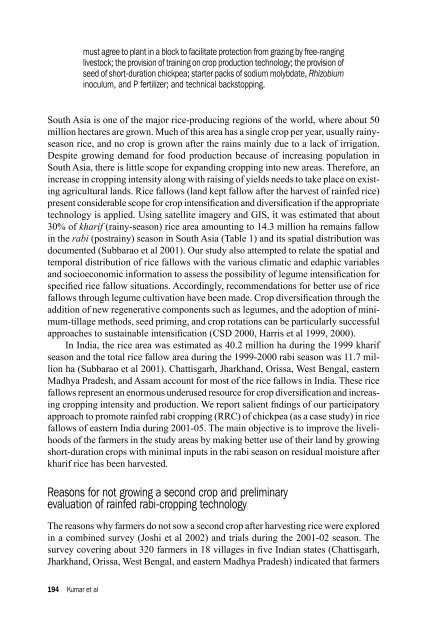Download (2461kB) - University of Greenwich
Download (2461kB) - University of Greenwich
Download (2461kB) - University of Greenwich
- No tags were found...
You also want an ePaper? Increase the reach of your titles
YUMPU automatically turns print PDFs into web optimized ePapers that Google loves.
must agree to plant in a block to facilitate protection from grazing by free-ranginglivestock; the provision <strong>of</strong> training on crop production technology; the provision <strong>of</strong>seed <strong>of</strong> short-duration chickpea; starter packs <strong>of</strong> sodium molybdate, Rhizobiuminoculum, and P fertilizer; and technical backstopping.South Asia is one <strong>of</strong> the major rice-producing regions <strong>of</strong> the world, where about 50million hectares are grown. Much <strong>of</strong> this area has a single crop per year, usually rainyseasonrice, and no crop is grown after the rains mainly due to a lack <strong>of</strong> irrigation.Despite growing demand for food production because <strong>of</strong> increasing population inSouth Asia, there is little scope for expanding cropping into new areas. Therefore, anincrease in cropping intensity along with raising <strong>of</strong> yields needs to take place on existingagricultural lands. Rice fallows (land kept fallow after the harvest <strong>of</strong> rainfed rice)present considerable scope for crop intensification and diversification if the appropriatetechnology is applied. Using satellite imagery and GIS, it was estimated that about30% <strong>of</strong> kharif (rainy-season) rice area amounting to 14.3 million ha remains fallowin the rabi (postrainy) season in South Asia (Table 1) and its spatial distribution wasdocumented (Subbarao et al 2001). Our study also attempted to relate the spatial andtemporal distribution <strong>of</strong> rice fallows with the various climatic and edaphic variablesand socioeconomic information to assess the possibility <strong>of</strong> legume intensification forspecified rice fallow situations. Accordingly, recommendations for better use <strong>of</strong> ricefallows through legume cultivation have been made. Crop diversification through theaddition <strong>of</strong> new regenerative components such as legumes, and the adoption <strong>of</strong> minimum-tillagemethods, seed priming, and crop rotations can be particularly successfulapproaches to sustainable intensification (CSD 2000, Harris et al 1999, 2000).In India, the rice area was estimated as 40.2 million ha during the 1999 kharifseason and the total rice fallow area during the 1999-2000 rabi season was 11.7 millionha (Subbarao et al 2001). Chattisgarh, Jharkhand, Orissa, West Bengal, easternMadhya Pradesh, and Assam account for most <strong>of</strong> the rice fallows in India. These ricefallows represent an enormous underused resource for crop diversification and increasingcropping intensity and production. We report salient fndings <strong>of</strong> our participatoryapproach to promote rainfed rabi cropping (RRC) <strong>of</strong> chickpea (as a case study) in ricefallows <strong>of</strong> eastern India during 2001-05. The main objective is to improve the livelihoods<strong>of</strong> the farmers in the study areas by making better use <strong>of</strong> their land by growingshort-duration crops with minimal inputs in the rabi season on residual moisture afterkharif rice has been harvested.Reasons for not growing a second crop and preliminaryevaluation <strong>of</strong> rainfed rabi-cropping technologyThe reasons why farmers do not sow a second crop after harvesting rice were exploredin a combined survey (Joshi et al 2002) and trials during the 2001-02 season. Thesurvey covering about 320 farmers in 18 villages in five Indian states (Chattisgarh,Jharkhand, Orissa, West Bengal, and eastern Madhya Pradesh) indicated that farmers194 Kumar et al
















